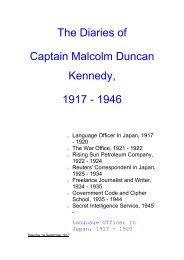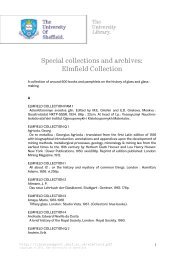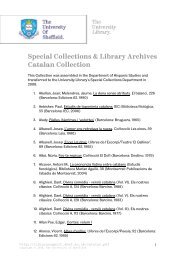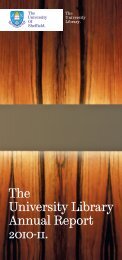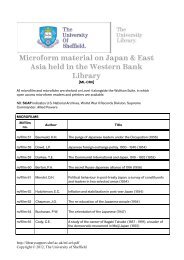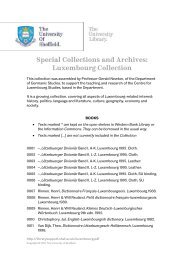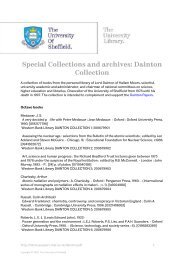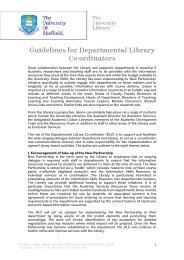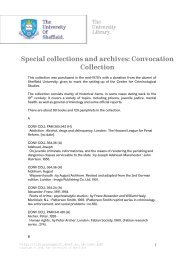The Geoffrey Bullough Collection - Temporary Home Page ...
The Geoffrey Bullough Collection - Temporary Home Page ...
The Geoffrey Bullough Collection - Temporary Home Page ...
You also want an ePaper? Increase the reach of your titles
YUMPU automatically turns print PDFs into web optimized ePapers that Google loves.
<strong>Bullough</strong> <strong>Collection</strong> No. 274 <strong>The</strong> Coming Race, by Edward Bulwer Lytton<br />
1. Publication details<br />
Author: Edward Bulwer Lytton, Baron<br />
Author dates: 1803-1873<br />
Title: <strong>The</strong> Coming Race<br />
Publication: Edinburgh; London: Blackwood, 1871<br />
First published: 1870<br />
Library reference: 200350870<br />
2. Genre / subgenre<br />
Science fiction (literary utopia)<br />
3. Brief Synopsis<br />
Traveller / observer‘s account of a highly developed race (the ‗Vril-ya‘) living beneath<br />
the surface of the Earth. Much discussion of the socio-political structures of the<br />
community, and particular emphasis on their language, supposed to be directly<br />
descended from Aryan.<br />
4. Overview of varieties / dialects<br />
Very little dialogue in this narrative, but interesting from the point of view of its<br />
narrative comments on dialects (i.e. the place of dialects within an entirely fictional<br />
invented language).<br />
5. Variety<br />
5a. Sample of dialect<br />
No actual varieties of English in this test – rather, where the language differs from<br />
standard English it is neologism (or ‗Vril-ya‘, the invented language of the futurebased<br />
subterranean community).<br />
5c. Dialect area represented<br />
See note at 5.<br />
5d. Density of dialect representation<br />
See note at 5.<br />
5e. Location of dialect<br />
See note at 5.<br />
5f. Characteristics of dialect speakers<br />
See note at 5.<br />
5g. Consistency of representation<br />
See note at 5.<br />
6. Narrative comments on dialects and varieties<br />
Lytton‘s text is unusual in that it pays detailed attention to the form and development<br />
of language (Chapter 12 discusses at length the grammar (especially inflection),<br />
vocabulary, and other unusual features of the Vril-ya language). Although this<br />
language is – as the narrator frequently notes – very different from English, he also<br />
suggests that this ‗perfect‘ language will also have dialects.<br />
First, the premise that Vril-ya has attained perfection:<br />
<strong>The</strong> language of the Vril-ya is peculiarly interesting, because it seems to me to<br />
exhibit with great clearness the traces of the three main transitions through<br />
which language passes in attaining to perfection of form (p. 84)<br />
Second, acknowledgement that this ‗perfect‘ language will include dialects:<br />
http://librarysupport.shef.ac.uk /bullough.pdf<br />
Copyright © 2007, <strong>The</strong> University of Sheffield<br />
65



